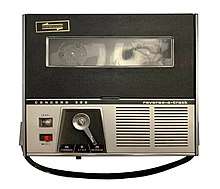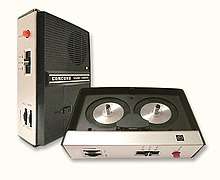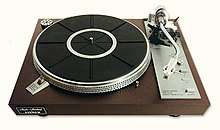Howard Ladd
Howard Philip Ladd was an electrical engineer, inventor, marketer, entrepreneur and bank founder. Ladd was a pioneering giant in American and international consumer audio and video electronics.
Howard Philip Ladd | |
|---|---|
| Born | Howard Philip Ladd April 5, 1921 Providence, Rhode Island, USA |
| Died | April 5, 2015 (aged 93) Los Angeles, California, USA |
| Occupation | Electrical engineer, inventor, marketer, entrepreneur, banker |
Biography
Ladd was the first of two sons born to Augusta Gertrude (née Feiner) and David Ladd in Providence, Rhode Island on April 5, 1921. Raised in Philadelphia, Pennsylvania, Ladd died on July 7, 2015 in Los Angeles, California.
Education and military career
Ladd graduated from the University of Pennsylvania with a degree in electrical engineering and earned an MBA from the Wharton School of Business.
Howard's prowess as a businessman and interest in technology were further developed during his four years in the U.S. Navy during WWII. Among many engineering projects, he was integrally involved in the development of radio controlled target drone aircraft. Upon his release from active duty, Howard visited Los Angeles and moved there.
Consumer electronics pioneer
The ten years after WWII saw Ladd actively involved in the formation of several businesses including a Southern California toy company. His great interest in technology led him back to electronics, setting him on the path to become a world business leader in the design and manufacturing of electronic equipment.
Concord Electronics

Ladd founded Concord Electronics, developing and marketing the first reel-to-reel and stereo audio compact cassette tape recorders that were sold in the U.S.. Most notably, in the 1960s, his Concord 5-inch reel-to-reel recorder was an entirely novel and innovative piece of electronic audio equipment. Ladd’s tape recorder became one of the most successful products in the electronics industry at that time.

In 1965, Concord offered the Concord F-20 "Sound Camera" tape recorder[1]. The unit used 2.5-inch tape reels with a rim-drive tape transport. It could record 20 to 30 minutes of audio. The F-20 was featured several times during the opening sequence of the Mission Impossible television series between 1966 and 1973.[2]
By 1966, Concord offered 18 different models of reel-to-reel recorders.[3]. For the next decade, Concord Electronics continued to innovate consumer recording products including the first portable, battery operated tape recorder with a built-in radio.
Concord produced the Conrad NAV-1 Marine Navigation System, licensing the patented process from inventor Daniel I Schneiderman. Schneiderman was a Jet Propulsion Laboratory scientist and was project manager of the Mars Mariner program and Ranger program. The device allowed boaters to quickly pinpoint their position and correct compass heading without using math.[4]
Early consumer video tape recording
Ladd was a pioneer in producing personal video tape recording equipment. 1n 1966, Concord introduced the VTR-600 video system at the Los Angeles High Fidelity Music Show. The three-piece system included a video recording unit, a nine-inch monitor and a Concord video camera. Ladd said the system was designed to meet the needs of professional communicators and wasn't aimed at the home market. The system retailed for $1500 (equivalent to $11,820 in 2019)[5].
Concord Electronics sold
In 1968, Ladd sold Concord Electronics to the New York based Ehrenreich Photo-Optical Industries, the exclusive US importer of Nikon photographic equipment.[6] The transaction cost Ehrenreich Photo-Optical Industries 44,000 shares of their common shares of stock. Additional payments were to be made "on the basis of future earnings". [7] Ladd remained with Concord as president for a year. Ehrenreich Photo-Optical Industries sold the Concord Electronics brand to Benjamin Electronic Sound Corp., a subsidiary of the New York based Instrument Systems Corporation in 1971.[8]
Sanyo and Fisher Electronics Corporation
In 1969 Ladd became the Executive Vice President and COO of the Sanyo Corporation. Ladd introduced the Sanyo brand to the United States in 1970.
In 1969, Fisher Electronics was acquired by Emerson Electric, who moved Fisher's manufacturing operations to Hong Kong due to high labor costs, but the company continued to suffer quality problems. Fisher's market share continued to drop precipitously.[9] In the early 1970s, Sanyo stepped in, revamping production to increase Fisher product quality. The cooperation between Emerson and Sanyo continued until May 1975, when Sanyo, which still had no American manufacturing affiliate, engineered the transfer of several Fisher product lines to Japan and rehabilitated a Fisher speaker plant at Milroy, Pennsylvania. While 50-50 partners, Sanyo and Emerson were unable to resolve numerous differences of opinion in regard to Fisher.[10]
Finally, Emerson agreed to sell its share in Fisher to Sanyo. Sanyo purchased Fisher Electronics from Emerson in May 1977.[11] Under Ladd’s leadership, the Fisher Corporation under Sanyo grew to be a multi-million dollar leader in the consumer electronics industry. The new, profitable Fisher Corporation moved its headquarters from New York to Ladd's Los Angeles. Ladd was named President and CEO of the combined Sanyo / Fisher Corporation in 1977, serving until 1987.[12]
In 1978, Ladd said his audio merchandising philosophy for Fisher audio equipment was "the right product at the right price at the right time. I know that sounds basic, but that's what we've been able to do". After a "broadening of product and technology philosophies", Ladd predicted "the remarkable turnaround" will see the "privately held subsidiary doing 100 million (equivalent to $391,989,796 in 2019) in annual sales".[9] Ladd was mistaken. The turnaround actually resulted in a return almost ten times greater then his prediction.[11]

Ladd's innovations at Fisher included the world's first linear motor, direct drive turntable, the Fisher MT 6225. It's unique drive system employed the turntable platter as the rotor of the motor. With no electrical connections to the rotor, there were no armature windings and all complicated electronic circuitry was in a stationary (non moving) position on a single PC board mounted under the platter on the turntable base.[13]
Ladd was instrumental at Sanyo in designing and promoting Fisher Quadraphonic sound audio equipment for the American market, producing 4-channel audio equipment in both SQ and Matrix formats. He said "we make all kinds of quadrasonic equipment because this is the business we're in... let the consumer buy the kind of software he prefers and we'll provide him the hardware to play it on".[14]
Sanyo also realized tremendous growth during Ladd's tenure in the 1970s; annual sales grew from $71.4 million (equivalent to $436,409,069 in 2019) in 1972 to $855 million (equivalent to $3,351,512,755 in 2019) in 1978.[11]
Growth in the video sector was slowed by Sanyo's ill-fated decision to adopt Sony's Betamax VCR format instead of Matsushita's VHS. Although initially successful, the Betamax eventually became all but obsolete. Sanyo avoided further damage by later switching to the VHS format.
In 1986, Sanyo's U.S. affiliate merged with Fisher to become Sanyo Fisher (U.S.A.) Corporation (later renamed Sanyo Fisher Company). The mergers made the entire organization more efficient, but also resulted in the departure of certain key executives, including Ladd, who had first introduced the Sanyo name to the United States in the early 1970s.[11]
Active in "retirement"
Ladd claimed he had retired at age 67, but he continued to stay active in many business opportunities.
Ladd and his associates founded the National Mercantile Bancorp in Century City, California in 1982. Ladd served as Chairman of the Board of Directors and Chief Executive Officer of the company and the bank. Ladd had been a director of the company since 1983 and of the bank since 1982. Ladd owned 1.9% of the bank at the time of acquisition by First California Bank.[15]
In May 1986, Ladd founded Ladd Electronics, incorporating the company in Los Angeles, California. Ladd was granted US utility patent US4912457A for a "Detector and message annunciator device", described as "an apparatus for detecting the presence of people and generating an audio message and/or a video display directed to the person or persons whose presence has been detected".[16]
Ladd founded Concord Media Systems in 1991. That company was the Assignee for US Utility Patent 5355161, an "Identification system for broadcast program segments".[17] The patent has been cited in numerous subsequent patent applications.
Ladd was Chairman of the Board of Concord Technology Development, an information systems company, from 1991 to 1995.
Projectavision, founded by Eugene Dolgoff in Westbury, New York was an early American producer of high image quality LCD projectors. Ladd joined the executive committee of the company in 1989 to “handle consumer marketing for the firm”.[18]
Ladd was an avid tennis player and lover of big band era music.[12]
Accolades
Ladd was inducted into the Consumer Electronics Industry Hall of Fame in October, 2006.
References
- "Concord Electronics". Billboard. Cincinnati, Ohio: Billboard Publishing Company. November 20, 1965. Retrieved March 16, 2020.
- Rick Maybury. "Tape Recorders and Players". www.dustygizmos.com. Retrieved March 16, 2020.
- "Tape Merchandise Sales Setting Brisk 1966 Pace". Billboard. Cincinnati, Ohio: Billboard Publishing Company. June 25, 1966. Retrieved March 15, 2020.
- US patent 3119108, Daniel I Schneiderman, "Radio beacon sensing means of navigation", issued January 21, 1964
- "Technical topics..." (PDF). Broadcasting. Washington, D.C.: Broadcasting Publications, Inc. April 25, 1966. Retrieved March 28, 2019.
- "Concord to Introduce 2 Cassette Units This Month". Billboard. Los Angeles, California: Billboard Publications, Inc. November 30, 1978. Retrieved March 28, 2019.
- "Concord Will Widen Base". Billboard. Los Angeles, California: Billboard Publications, Inc. November 23, 1968. Retrieved March 28, 2019.
- "Benjamin's Personal Field Surveys Aid His Decisions". Billboard. Los Angeles, California: Billboard Publications, Inc. January 1, 1971. Retrieved March 29, 2019.
- Jim MccCullagh (September 30, 1978). "Fisher Turnaround". Billboard. Los Angeles, California: Billboard Publications, Inc. Retrieved March 28, 2019.
- Chandler, Jr., Alfred D. (2005). Inventing the Electronic Century: The Epic Story of the Consumer Electronics and Computer Industries. Cambridge, Massachusetts: Harvard University Press. p. 68.
- "SANYO Electric Co., Ltd". 2006. Retrieved March 27, 2019.
- "Obituary Notices". The Los Angeles Times. Los Angeles, California. August 29, 1908. Retrieved March 27, 2019.
- "More Hi Fi/Semi-pro Crossover Units in CES Showcase". Billboard. Los Angeles, California: Billboard Publications, Inc. June 25, 1977. Retrieved March 28, 2019.
- "Sanyo to Bow TVC, 9 Music Systems". Billboard. Los Angeles, California: Billboard Publications, Inc. May 5, 1973. Retrieved March 28, 2019.
- Securities & Exchange Commission (April 30, 1997). FILED WITH THE SECURITIES AND EXCHANGE COMMISSION ON APRIL 30, 1997 - REGISTRATION NO. 333-21455 (Report). Retrieved March 29, 2019.
- US patent 4912457A, Howard P Ladd, "Detector and message annunciator device", issued March 27, 1990
- US patent 5355161, "Identification system for broadcast program segments", issued March 27, 1990
- Hart, Jeffrey (1992). "Display's the Thing: The Real Stakes in the Conflict Over High Resolution Displays" (PDF). Berkeley, California: Berkeley University. Retrieved March 28, 2019.